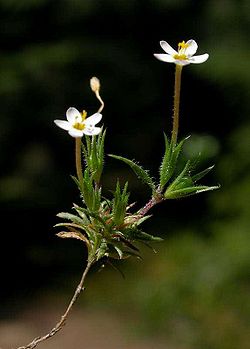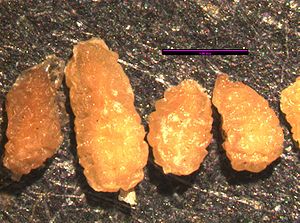Difference between revisions of "Leptosiphon bicolor"
| Line 1: | Line 1: | ||
| − | + | ''Linanthus bicolor'' commonly known as true baby star is a flowering plant, part of the Phlox family (Polmoniaceae). | |
| − | |||
| − | + | [[File:LEBI BenLegler flw good1.jpg|250px|thumb|right|Flower Profile]] | |
| − | + | ||
| − | + | ||
==Taxonomy== | ==Taxonomy== | ||
| − | + | ---- | |
| − | + | ||
| − | + | ||
| − | + | ||
*'''Kingdom''': Plantae | *'''Kingdom''': Plantae | ||
| Line 24: | Line 18: | ||
| − | |||
| − | + | ==Description== | |
---- | ---- | ||
| Line 35: | Line 28: | ||
| − | + | ==Bloom Period== | |
---- | ---- | ||
| − | |||
April- June | April- June | ||
| − | + | ==Distribution== | |
| − | + | ||
---- | ---- | ||
| − | |||
West of the Cascades, Vancouver Island, B. C., to California, east through the Columbia Gorge | West of the Cascades, Vancouver Island, B. C., to California, east through the Columbia Gorge | ||
| − | + | ==Habitat== | |
---- | ---- | ||
Mesic to dry, open, grassy places in the lowland zone; locally frequent on S Vancouver Island and the Gulf Islands; S to CA. | Mesic to dry, open, grassy places in the lowland zone; locally frequent on S Vancouver Island and the Gulf Islands; S to CA. | ||
| − | + | ==Uses== | |
| − | + | ||
---- | ---- | ||
None found (at the moment) | None found (at the moment) | ||
| − | + | ==Propagation== | |
| − | + | ||
---- | ---- | ||
| − | |||
Seeds were sown into cone-tainers filled with Sunshine # 1 (a soil-less, peat-based media) amended with micro-nutrients (Micromax) and a slow-release fertilizer (Osmocote 14-14-14). Flats of conetainers were placed in greenhouse set at moderate temperatures (70 degree days/50 degree nights.) Seeds germinated readily with no treatment. Most seeds germinated within one to two weeks. (Leptosiphon grandiflorus also needed no treatment before germination). | Seeds were sown into cone-tainers filled with Sunshine # 1 (a soil-less, peat-based media) amended with micro-nutrients (Micromax) and a slow-release fertilizer (Osmocote 14-14-14). Flats of conetainers were placed in greenhouse set at moderate temperatures (70 degree days/50 degree nights.) Seeds germinated readily with no treatment. Most seeds germinated within one to two weeks. (Leptosiphon grandiflorus also needed no treatment before germination). | ||
| + | ==Photo Gallery== | ||
| + | ---- | ||
| + | |||
| + | |||
| + | |||
| + | |||
| + | |||
| + | |||
| + | |||
| + | |||
| + | |||
| + | |||
| + | |||
| + | |||
| + | |||
Revision as of 11:04, 7 May 2012
Linanthus bicolor commonly known as true baby star is a flowering plant, part of the Phlox family (Polmoniaceae).
Contents
Taxonomy
- Kingdom: Plantae
- Phylum: Magnoliophyta
- Class: Magnoliopsida
- Order: Ericales/ Solanales
- Family: Polemoniaceae
- Genus: Leptosiphon
- Species: bicolor
Description
General: Slender annual up to 1.5 dm. tall, the stem puberulent, often branched at the base, otherwise usually simple. Leaves: Leaves rather firm, palmately 3-7 cleft, up to 2 cm. long, the segments linear, harshly ciliate. Flowers: Flowers fragrant, sub-sessile in a dense, terminal, leafy cluster, the inflorescence leaves longer and more prominently ciliate than the lower; calyx firm, 5-10 mm. long, the 5 segments with needle-like tips; corolla with a very slender tube up to 3 cm. long, the throat yellow, the 5 abruptly-flaring, short lobes deep pink to purplish or white; stamens 5, the filaments attached in the corolla throat; style 3-parted; ovary superior. Fruit: Capsule with 3, several-seeded carpels.
Bloom Period
April- June
Distribution
West of the Cascades, Vancouver Island, B. C., to California, east through the Columbia Gorge
Habitat
Mesic to dry, open, grassy places in the lowland zone; locally frequent on S Vancouver Island and the Gulf Islands; S to CA.
Uses
None found (at the moment)
Propagation
Seeds were sown into cone-tainers filled with Sunshine # 1 (a soil-less, peat-based media) amended with micro-nutrients (Micromax) and a slow-release fertilizer (Osmocote 14-14-14). Flats of conetainers were placed in greenhouse set at moderate temperatures (70 degree days/50 degree nights.) Seeds germinated readily with no treatment. Most seeds germinated within one to two weeks. (Leptosiphon grandiflorus also needed no treatment before germination).
Photo Gallery
Seed
Abbreviation: LEBI
Seed sample from: 2011
Average Measurement: 1.3 x 0.8 x 0.7
Measurement Range: L: 1.1 – 1.75, W: 0.6 – 1, D: 0.5 – 1
Features
Shape: Seeds somewhat tear shaped, others elliptical.
Color: Seeds partially translucent and brown. Hilium inconspicuous.
Surface: Seeds bumpy and somewhat corrugated, giving them a “brain-like” texture. Seeds slightly glossy.
Latitudinal Cross Section: elliptical 
Longitudinal cross section: elliptical ![]() , and at times, obovate
, and at times, obovate ![]()
References


